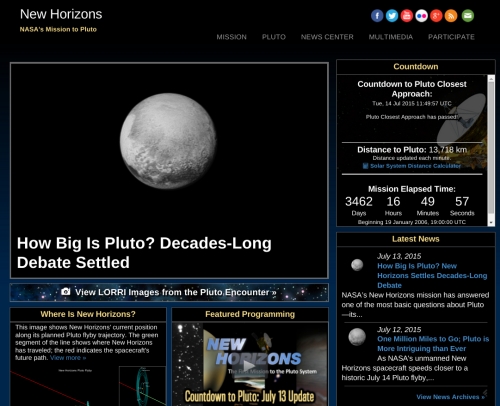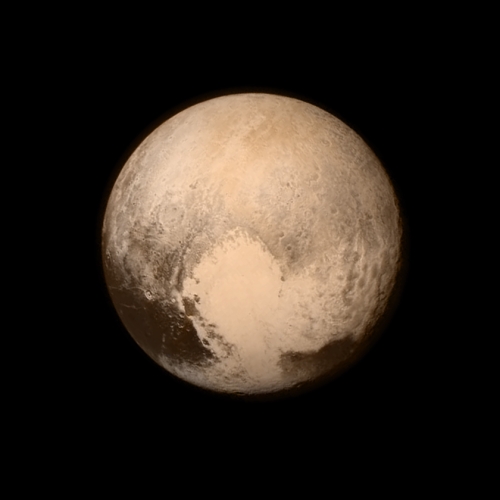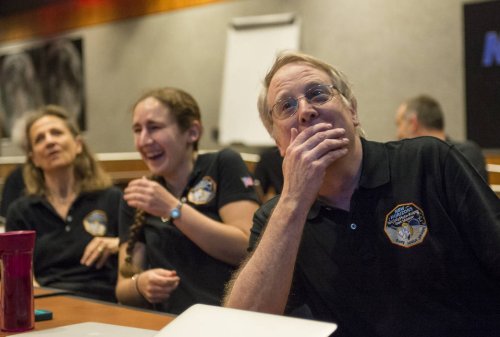
Closest approach for New Horizons was at 0749:57 EDT (1149:57 UTC), with closest approach to Charon at about 0806 EDT. Mission operations manager Alice Bowman told the media briefing that we arrived at Pluto 72 seconds early and 70 kilometers closer than the aiming point, all of which was well within mission specs. Nice work.
I’ve found Twitter the best place to keep up, along with NASA TV for the media briefings. The #PlutoFlyby hashtag has been so active that it’s sometimes hard to read the messages, a heartening demonstration of the powerful sentiment this mission invokes. I also track @New Horizons2015, @NASANewHorizons, @AlanStern and, of course, @elakdawalla — Emily Lakdawalla’s work has been definitive. The Twitterverse has been exploding.
And here is the latest image, showing 4 kilometers per pixel, about 1000 times higher than Hubble can provide. Much better still to come. Here we’re sixteen hours from closest approach, at a distance of 766,000 kilometers. Note the varying areas of brightness, with very bright terrain just north of the equator. It’s a surface, says Alan Stern, that shows a history of impact and surface activity, but we have so much yet to learn as more data arrive.

The New Horizons team saw the image above for the first time this morning around 0545 EDT.

Image: Members of the New Horizons science team react to seeing the spacecraft’s last and sharpest image of Pluto. Credit: NASA / JHU/APL.
And now we wait. Stern estimates no more than two chances in 10,000 that we’ll lose New Horizons due to impact with debris, but until we get tonight’s signal, this writer at least is going to be on edge. After all, we’re crossing the orbital plane.



I’ve been waiting 45 years for this day to come – ever since I first read as a kid that NASA’s “Grand Tour” mission was suppose to target Pluto. As we wait for the first results of New Horizons’ close encounter with Pluto to be sent back to Earth, it may seem odd that now is a good time to start thinking about a follow on mission to this distant world. Considering how long it took to get New Horizons off the ground and to Pluto, it might be a quarter century before we revisit Pluto to get a better look at its Charon-facing hemisphere and answer the questions raised by New Horizons.
http://www.drewexmachina.com/2015/07/13/the-next-pluto-mission/
Alan Stern just told the media briefing that he’s been secretly working on a Pluto lander. He delivered the line as a joke, but made it clear that we need to get back out there. In any case, as you note, it’s going to be a long time.
@Paul Gilster July 14, 2015 at 9:20
Barring any serious breakthroughs in the development of nuclear-based propulsion systems, we probably won’t see a lander or orbiter mission reaching Pluto until about 2050 or beyond. And given our experience waiting for a post-Voyager follow on missions to Uranus and Neptune, it could easily be well into the second half of this century before it actually happens. It’s unlikely I will live long enough to witness it.
Treat shot, congrats to N Horizon team
Some great Irony: the photograph with out latest modern equipment.
makes Pluto look as if it were Illustrated on old Newspaper print, (it has that patina)
A simple list of what scientific goals are to be achieved would be very helpful for taxpayers. A simple explanation of these goals, minus the specific instrument package names, would also be very helpful as well.
In addition, I’m sure buried somewhere in the New Horizons site at NASA all of the questions below are answered, but who has time to sift through the voluminous data?
* What is the power source for generating electricity on New Horizons?
* Are all the scientific packages used at the same time during the flyby?
* What is the peak power use for New Horizons?
Thanks
10/10
From when Voyager 2 flew by Uranus in 1986 until today, we’ve done a tour of the ten nearest planets and dwarf planets.
All in my lifetime. Makes me feel better about being in my 30s.
Next up, Eris?
This last pre-flyby image looks disappointingly flat, almost like a painted sphere. I can almost see the conspiracy theorists using this as proof that the flyby was a studio fake, even though Nasa could have used CG to make a much more interesting picture.
While the close approach images should be stunning, I am waiting for the data on the surface composition. If we get similar data for Charon, it will be instructive to compare the 2 bodies. Such a pity we won’t likely be back in my lifetime. We will no doubt look back on 2015 as the year of close encounters in space.
Black Sci-Fi said on July 14, 2015 at 11:16:
“A simple list of what scientific goals are to be achieved would be very helpful for taxpayers. A simple explanation of these goals, minus the specific instrument package names, would also be very helpful as well.”
The official New Horizons Website does a pretty good job of distilling down the information you listed. Check out the Mission section as just one example:
http://pluto.jhuapl.edu/Mission/index.php
Took a matter of seconds to find via Google, by the way.
Here is an excellent concise article on what has happened, is happening, and will happen with New Horizons:
http://blogs.agu.org/wildwildscience/2015/07/13/this-is-why-you-have-not-seen-a-bunch-of-images-of-pluto-this-weekend/
The closest we’ll get to a Pluto lander with current technology is a penetrator. Considering that no penetrator mission has succeeded (at much lower impact speeds), I think this is it for Pluto for many, many decades.
I’d rather see a mission to Sedna (or one of its sister worlds) – even a flyby.
It seems that an all-out attempt to kill most of the relative velocity to Pluto and achieve at least a large eccentric orbit would have been thwarted by insufficient fuel. Do we know how close they were to being able to achieve this?
Return to Pluto was raised @ presser. Oneof the designers said he is working on an orbiter lander idea. Maybe it is nuclear.
Has anyone else noticed that you take the new image of Pluto , full screen, your monitor or IPAD stand back about 10 or 20 feet and it looks like Mars?!
Kinda sorta.
Visions of Giovanni Schiaparelli!
Lets hope JWST will finally finish, launch and deploy successfully, let’s also hope Europa Clipper will fly.
Its very sad that LISA is cancelled.
Dare not wish more. :-(
Pleased very much by the final approach of New Horizons to Pluto. JPL and NASA have done some great work here.
I’d like to congratulate Professor Michael Summers of George Mason University. Professor Summers is Co-Principle Investigator of this planetary science mission. I took two courses in atmospheric physics taught by Professor Summers. The professor has a brilliant mind and was easily able to convey the advanced mathematics of the course content to me. We even met before class where he would tutor me on the next class lecture material.
Many kudos also go out to all of the other folks who helped bring this mission to success. The cool thing about all of this is that the probe is 1/5 of a light-day away. Quite amazing when you stop to realize that the speed of light is about equal to travel around the Earth’s equator 7.5 times per second.
I would imagine that with all the nine planets reconnoitered now that the next step would probably be more closer examination of the inner planets around Earth. Would all you think that would be more likely be the future planning of NASA? I say this because of the fact that these outer planetary missions are so expensive to conduct as compared to more local neighborhoods around the earth, and that means less cost. Anyone agree on that?
@Andrew Palfreyman
wasn’t the lack of fuel a requirement for this probe simply because they wanted to get it there at the least amount of time and at the highest velocity? I thought that was the thinking behind all this?
I eagerly anticipate the atmospheric findings, too–do Pluto and Charon share an atmosphere, and if so, to what extent? Focusing my attention on the limb, I thought: “Like Triton…” I won’t be surprised–but not one whit disappointed, either–if closer-in views reveal “cantaloupe terrain” and cryo-geysers like what we saw on Triton. It will be very interesting when full-globe views of both worlds can be compared, but maybe we won’t -have- to pine for additional missions out there in order to obtain such views:
A few days ago someone posted, in a comment to an earlier article in this “current Pluto batch” (I can’t find it just now), that exoplanets could be imaged at 100 km resolution with an Earth-based (I think) interferometer array of optical telescopes 1,000 km across (if memory serves). If this is correct, a more modest-sized array of optical telescopes–with adaptive optics and laser “guide stars”–should be able to view Pluto (and Triton, Neptune, and KBOs) at resolutions comparable to what New Horizons gave us.
Andrew Palfreyman:
Very, very far. At the velocity New Horizons is going, it would take a rocket not much smaller than the one that launched it to put it into orbit. Orbiters and landers will have to await nuclear electric propulsion, at least.